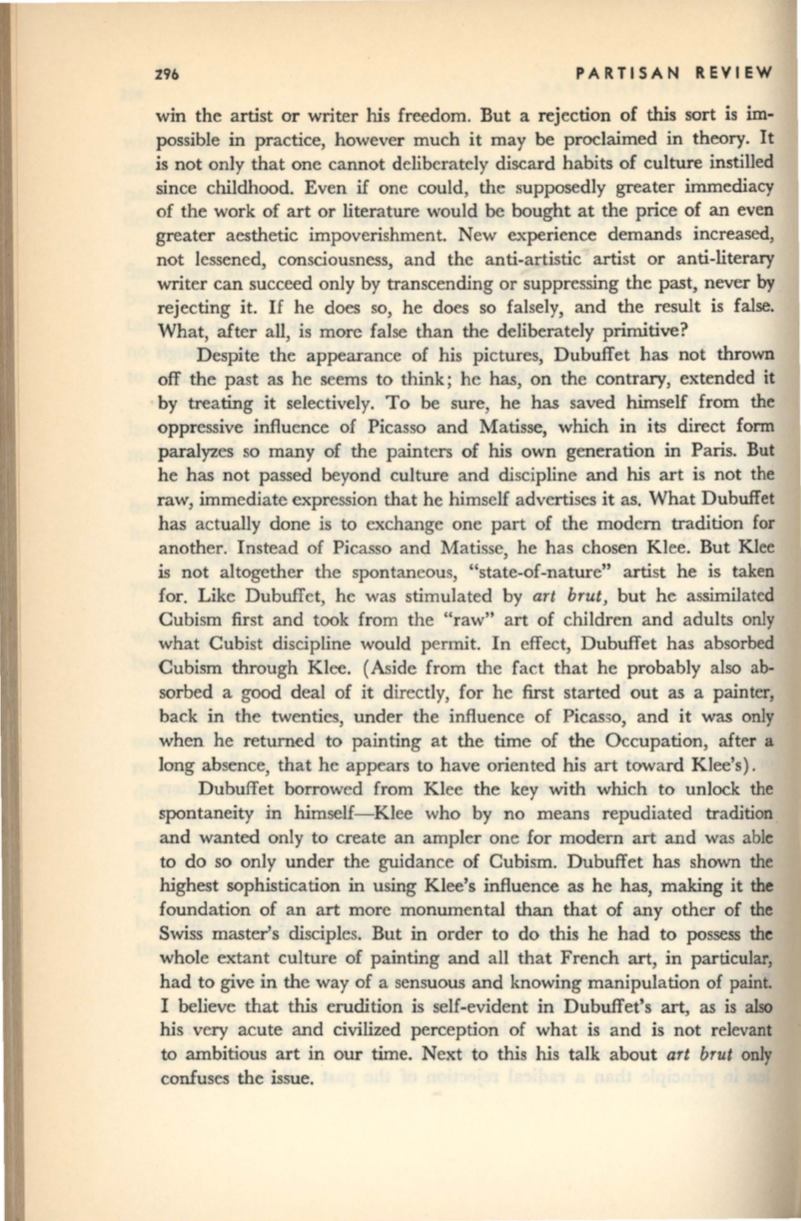
29b
PARTISAN REVIEW
win the artist or writer his freedom. But a rejection of this sort is im–
possible in practice, however much it may be proclaimed in theory. It
is not only that one cannot deliberately discard habits of culture instilled
since childhood. Even
if
one could, the supposedly greater immediacy
of the work of art or literature would be bought at the price of an even
greater aesthetic impoverishment. New experience demands increased,
not lessened, consciousness, and the anti-artistic artist or anti-literary
writer can succeed only by transcending or suppressing the past, never by
rejecting it.
If
he does so, he does so falsely, and the result is false.
What, after all, is more false than the deliberately primitive?
Despite the appearance of his pictures, Dubuffet has not thrown
off the past as he seems to think; he has, on the contrary, extended it
by treating it selectively. To be sure, he has saved himself from the
oppressive influence of Picasso and Matisse, which in its direct fonn
paralyzes so many of the painters of his own generation in Paris. But
he has not passed beyond culture and discipline and his art is not the
raw, immediate expression that he himself advertises it as. What Dubuffet
has actually done is to exchange one part of the modem tradition for
another. Instead of Picasso and Matisse, he has chosen Klee. But Klee
is not altogether the spontaneous, "state-of-nature" artist he is taken
for. Like Dubuffet, he was stimulated by
art brut,
but he assimilated
Cubism first and took from the "raw" art of children and adults only
what Cubist discipline would permit. In effect, Dubuffet has absorbed
Cubism through Klee. (Aside from the fact that he probably also ab–
sorbed a good deal of it directly, for he first started out as a painter,
back in the twenties, under the influence of Picasso, and it was only
when he returned to painting at the time of the Occupation, after a
long absence, that he appears to have oriented his art toward Klee's).
Dubuffet borrowed from Klee the key with which to unlock the
spontaneity in himself-Klee who by no means repudiated tradition
and wanted only to create an ampler one for modern art and was able
to do so only under the guidance of Cubism. Dubuffet has shown the
highest sophistication in using Klee's influence as he has, making it the
foundation of an art more monumental than that of any other of the
Swiss master's disciples. But in order to do this he had to possess the
whole extant culture of painting and all that French art, in particular,
had to give in the way of a sensuous and knowing manipulation of paint.
I believe that this erudition is self-evident in Dubuffet's art, as is also
his very acute and civilized perception of what is and is not relevant
to ambitious art in our time. Next to this his talk about
art brut
only
confuses the issue.


